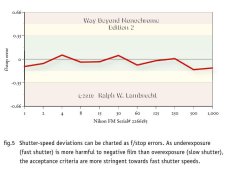JMC1969
Subscriber
I was not particularly sure where to post this thread so hopefully the people interested will find it here.
Recently I have been trying to sell a couple of Minolta x-570 camera bodies here on APUG. Obviously the question came up as to their condition so I put them to the test of the shutter tester. Which, I had not had the chance to really sit down and figure out how to use. Now I have and have some question as to what is expectable when shutter speeds are not right on the money. Funny enough, these two camera bodies are almost dead on. I thought this was just about impossible, so I got out my old standby camera I have been using for years and never had a problem with. Canon F-1. This camera's times seem way off and I have never had a bad exposure due to shutter malfunction. I assume the big difference here is, the Minolta's are electronically fired and The Canon is mechanically fired, being that the Minolta needs the battery to trip shutter and the Canon does not.
The up hill battle begins down the mathematical road in trying to figure out exactly what the time differences mean in an F-stop scenario.
This is the chart I am using as a reference for correct shutter speeds. These times and tests are based on the camera mounted without a lens so there is no iris to calculate for, just straight speed of curtain travel.

Next is the test I ran on the Canon F-1. Four (4) consecutive shutter trips, then averaged. The percentage you see to the far right is the percentage of difference from the correct speed the shutter should be traveling.

In my previous job, I dealt with digital capturing of art work for reproduction. Correct color is a must as to match the original piece. Through this, I learned quite a bit about color and how it is translated to "computer talk". This, including "Delta E". Not to get too into this subject, but simply for where I am going with this. One (1) measurement of Delta E is said to be the equivalent of one (1) shade difference in color that the human eye can differentiate between.
So in relevance to this subject, does it apply to density?
What percentage of correct shutter speed can the human eye detect?
What does that translate into as fraction of F-stops?
Can you actually see the difference in a shutter that is 25% (from perfect) or a 1/4 stop (either way) different? Is it 20%/ 1/5 stop? 10%/ 1/10 stop?
I have searched high and low to find the answer over the past few days. Maybe I am not posing the question correctly in my searches. I have re-familiarized myself with LUX, Lumens, Footcandles and still can not really come up with a definitive answer.
Any help/discussion is greatly appreciated.
Jody
Recently I have been trying to sell a couple of Minolta x-570 camera bodies here on APUG. Obviously the question came up as to their condition so I put them to the test of the shutter tester. Which, I had not had the chance to really sit down and figure out how to use. Now I have and have some question as to what is expectable when shutter speeds are not right on the money. Funny enough, these two camera bodies are almost dead on. I thought this was just about impossible, so I got out my old standby camera I have been using for years and never had a problem with. Canon F-1. This camera's times seem way off and I have never had a bad exposure due to shutter malfunction. I assume the big difference here is, the Minolta's are electronically fired and The Canon is mechanically fired, being that the Minolta needs the battery to trip shutter and the Canon does not.
The up hill battle begins down the mathematical road in trying to figure out exactly what the time differences mean in an F-stop scenario.
This is the chart I am using as a reference for correct shutter speeds. These times and tests are based on the camera mounted without a lens so there is no iris to calculate for, just straight speed of curtain travel.

Next is the test I ran on the Canon F-1. Four (4) consecutive shutter trips, then averaged. The percentage you see to the far right is the percentage of difference from the correct speed the shutter should be traveling.

In my previous job, I dealt with digital capturing of art work for reproduction. Correct color is a must as to match the original piece. Through this, I learned quite a bit about color and how it is translated to "computer talk". This, including "Delta E". Not to get too into this subject, but simply for where I am going with this. One (1) measurement of Delta E is said to be the equivalent of one (1) shade difference in color that the human eye can differentiate between.
So in relevance to this subject, does it apply to density?
What percentage of correct shutter speed can the human eye detect?
What does that translate into as fraction of F-stops?
Can you actually see the difference in a shutter that is 25% (from perfect) or a 1/4 stop (either way) different? Is it 20%/ 1/5 stop? 10%/ 1/10 stop?
I have searched high and low to find the answer over the past few days. Maybe I am not posing the question correctly in my searches. I have re-familiarized myself with LUX, Lumens, Footcandles and still can not really come up with a definitive answer.
Any help/discussion is greatly appreciated.
Jody











